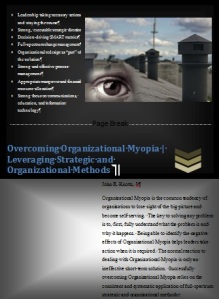 Many people start their own business for a variety of reasons: extra income, want to be their own boss, freedom of when and when not to work, stay at home parent, and a whole host of other reasons. However, many of these businesses fail over time, often because the owner didn’t document, follow, and constantly update a strategic business plan. The often overlooked and seldom thought about aspects of any strategic and business plan, is deep down, why you’re doing what you’re doing and where you want it to go — the mission and vision. Sure, many companies have an idea and even some of them they write it down. But, how good are these statements for your company?
Many people start their own business for a variety of reasons: extra income, want to be their own boss, freedom of when and when not to work, stay at home parent, and a whole host of other reasons. However, many of these businesses fail over time, often because the owner didn’t document, follow, and constantly update a strategic business plan. The often overlooked and seldom thought about aspects of any strategic and business plan, is deep down, why you’re doing what you’re doing and where you want it to go — the mission and vision. Sure, many companies have an idea and even some of them they write it down. But, how good are these statements for your company?
Join John Knotts, a strategic business advisor with over 25 years’ experience working with companies of all sizes to improve their business operations. The first questions he asks in any engagement are: what do you do, why do you do it, where are you today, and where are you going. These questions begin to form, what he calls, the ‘Strategic Bridge’, a visual representation of your strategy at work.
Bring your current mission and vision statements for you company and let’s examine, along with John, what you do and why you do it.
Bulverde Spring Branch Business Networking
Friday, August 18, 2017, 8:45 am
St. Paul Lutheran Church of Bulverde (The Red Roof Church)
29797 US-281, Bulverde TX 78163
Free to attend




